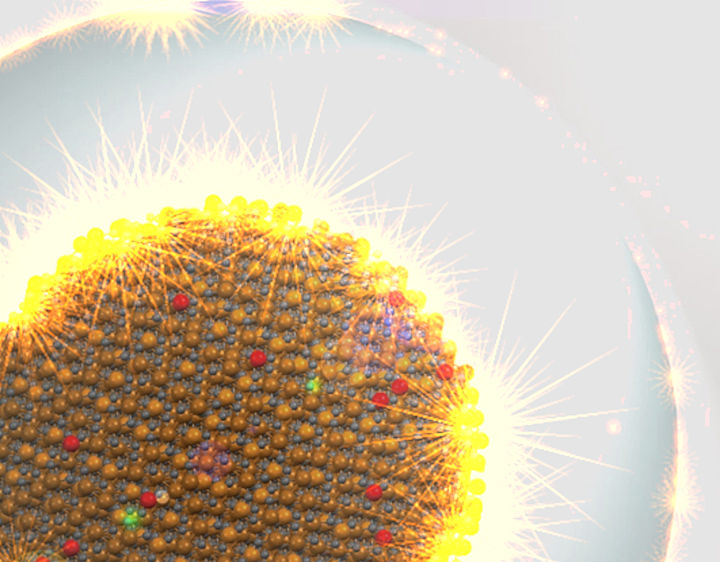Medical theranostics
Magnetic nanoparticles can be used for many medical applications, e.g. cell labelling, targeted drug delivery, as contrast agents in magnetic resonance imaging (MRI) or in hyperthermia cancer treatment. For all these applications, the nanoparticles have to biocompatible like e.g. ferrite nanoparticles we investigate.
In our reasearch, we focus on improving the magnetic properties of biocompatible nanoparticles by interface effects upon covering or decoration with other suitable materials.

MRI contrast agentsOpen areaClose area
Magnetic resonance imaging (MRI) is based on nuclear magnetic resonance (NMR) which describes the resonant absorption of an alternating magnetic field applied perpendicularly to a static magnetic field. Resonant absorption occurs if the frequency of the alternating magnetic field equals the Larmor precession frequency of the nuclear magnetic moments. For MRI, usually NMR of hydrogen nuclei, i.e. protons, is used because hydrogen is present in all biological tissues.
The macrospin of the nanoparticles is connected to a large magnetic stray field that alters the relaxation time of the protons in the nearest environment. In general, there three different relaxation times exist: T1, T2 and T2*. The longitudinal relaxation time T1, is the decay constant for the recovery of the nuclear spin magnetisation component along the direction of the external magnetic field towards its thermal equilibrium value. It is commonly called spin-lattice relaxation since it involves the exchange of energy with its surroundings. The transverse relaxation time T2 is the decay constant for the magnetisation component perpendicular to the external field and corresponds to a phase decoherence of the transverse nuclear spin magnetisation. Since T2 is affected only by the dynamics of the nuclear spins, it is called spin-spin relaxation time. Magnetic field inhomogeneities yield a distribution of resonance frequencies resulting in a dephasing of nuclear spins as well. The latter decay constant is denoted T2*. The use of magnetic nanoparticles as contrast agents indirectly influences the T2 and T2* relaxation. This gives rise to a higher contrast in the spin echo MRI which is used as a method to visualise the transverse relaxation behaviour. Besides biocompatibility, a high net magnetic moment of the nanoparticles is an important requisite for a high MRI contrast. Therefore, e.g., magnetite (Fe3O4) nanoparticles are favoured over maghaemite (γ-Fe2O3) as contrast agents.
HyperthermiaOpen areaClose area
Cancer treatment using hyperthermia was already successfully tested for functionalised Fe oxide nanoparticles and is approved in the EU for the treatment of brain tumours. The iron oxide nanoparticles - γ-Fe2O3 (maghaemite) or Fe3O4 (magnetite) - can be injected directly into a tumour similar to a biopsy procedure, injected into the arterial supply of tumour tissue, and/or it will be enriched at tumour sites by an appropriate antibody-conjugation. The latter is advantageous, if the hyperthermia treatment must be repeated, while the direct injection is usually connected to a higher local concentration of nanoparticles.
By application of an alternating magnetic field, the particles generate heat that may destroy the surrounding cancer cells or support chemotherapies where already a moderate tissue heating leads to a more effective cell destruction.